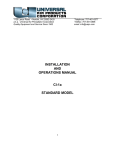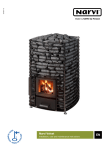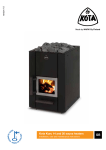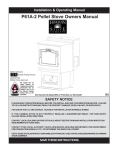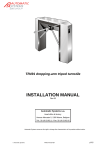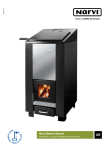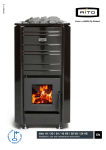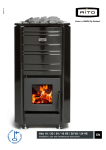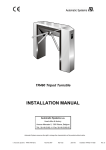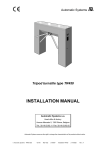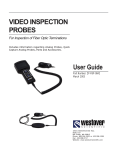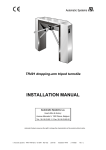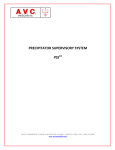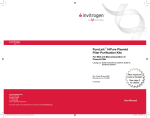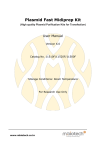Download installation and operation manual d4 residential horizontal and
Transcript
1135 Lance Road • Norfolk, VA 23502-2429 a.k.a. Universal Air Precipitator Corporation Quality Equipment and Service Since 1962 Telephone: 757-461-0077 Telefax: 757-461-0808 email: [email protected] INSTALLATION AND OPERATION MANUAL D4 RESIDENTIAL HORIZONTAL AND VERTICAL STANDARD MODEL MM-R1 TABLE OF CONTENTS SECTION I OPERATING PRINCIPLE 3 SECTION II GENERAL DESCRIPTION 3 SECTION III STEPS FOR INSTALLATION 3 Unpack Remove Power Pack Remove Cabinet Access Panel Remove Ionizing-Collecting Cell(s) Remove After-Filter(s) Determine Location of Precipitator Floor-Mounted -- Horizontal Flow Suspended -- Horizontal Flow Vertical Down Flow Horizontal Direction of Air Flow Connect Duct Work 3 3 3 3 3 3 3 3 3 3 4 REASSEMBLE UNIT 4 Install After-Filter Install Ionizing-Collecting Cell(s) Install Access Panel Install Power Pack Connect Electricity Install Instructions 4 4 4 4 5 5 FINAL CHECK 5 Electrical 5 INSTRUCTING THE OWNER 6 A. B. C. D. E. F. G. SECTION IV A. B. C. D. E. F. SECTION V A. SECTION VI 2 MM-R1 I. OPERATING PRINCIPLE The Universal Air precipitator is installed in the return air duct of a heating or airconditioning system. It is positioned in the main return air trunk so that all return air passes through it. The airborne particles (as small as 1 / 250,000 of an inch) that enter the precipitator acquire a positive electrical charge. The charged particles continue into the collecting plates section, where they are repelled by another electrical field onto the collector plates. A power pack converts 115 volts alternating current to 7,500 volts direct current to supply the necessary voltage for the ionizing-collecting cell(s). II. GENERAL DESCRIPTION The Universal Air precipitator Standard Model is designed for horizontal air flow from left to right, or right to left, and for vertical down flow with discharge to left or right. It is comprised of five distinct functional components, as follows: 1. Power pack with access cover and safety screw for supplying high voltage direct current to the ionizing-collecting cell(s). 2. Ionizing-collecting cell(s) consisting of fine tungsten wire suspended between flat electrodes, which are mounted in the air entering side of a series of parallel aluminum plates. 3. An after-filter to provide back pressure to assure uniform air distribution through the ionizing-collecting cell(s). III. STEPS FOR INSTALLATION A. B. C. D. E. Unpack 1. Carefully remove precipitator from carton. 2. Remove all shipping retainers. Remove Power Pack 1. Remove access cover. It is retained with the long safety screw located at the top front center. 2. Detach high voltage lead from through-panel insulator. 3. Lift power pack up and out. 4. Set aside power pack and cover until installation of cabinet is complete. Remove Cabinet Access Panel 1. Turn latch and pull. Remove Ionizing-Collecting Cell(s) 1. Remove all temporary shipping retainers. 2. Pull cell(s) from cabinet. Care must be taken not to injure the collecting plates. Remove After-Filter 1. For horizontal flow units, slide after-filter toward the rear and pull out. 3 MM-R1 2. F. G. IV. For vertical flow units, pry up at the bottom of after-filter and pull toward inside of cabinet. Determine Location of Precipitator 1. The precipitator must be positioned in the main return air trunk so that all return air passes through it. 2. Provide sufficient space in front of access panel for cell removal and service. 3. Avoid sharp turns or narrow transitions in the air entering or leaving side of the precipitator to assure uniform distribution of air over the face of the ionizing-collecting cell(s). 4. When the precipitator is used for a commercial or industrial application and is to be installed near a fresh-air intake, it is advisable to precede it with preheat coils to minimize condensation forming on the ionizing-collecting cell(s). In addition, rain louvers should be installed ahead of the intake area to reduce the entry of rain or snow into the plenum chamber. 5. It is good practice to install a #10 or #12-mesh insect screen over the intake area to prevent large foreign particles or insects from reaching and shorting out the ionizing-collecting cell(s). Floor-Mounted - - Horizontal Flow A base may be made to support the horizontal flow precipitator, or a factorymade stand may be purchased for this purpose. Suspended - - Horizontal Flow Four (4) 5/16” by 1” bolts are located on each corner of the cabinet top for the purpose of attaching suspension hangers. Suspension hangers such as eye-bolts and/or steel channels drilled to match the ceiling joists spacing and holes in the cabinet top, are satisfactory. Vertical Down Flow The vertical down flow precipitator is provided for air flow either to the right or the left. It is not necessary to rearrange the components. The unit must set level on the floor. Horizontal Direction of Air Flow The Universal Air precipitator, as received, is assembled for the air flow through the unit from left to right (when facing the access panel). Changing the direction of air flow is easily accomplished and will be covered in the steps that follow. Connect Duct Work The duct work necessary to install a precipitator will vary with each installation. 1. Remove water manifold from precipitator. 2. Install all ducts inside the precipitator collars. 3. For horizontal flow units, the duct, running on both the air entering and leaving sides, should be sloped toward the cabinet drain and caulked. 4. The duct in the air leaving side should be attached inside far enough to cover the unused manifold holes. 5. The duct work should be air tight between the precipitator and system blower to prevent drawing dirt-laden air in with the air already cleaned. REASSEMBLE UNIT A. B. Install After-Filters 1. Place after-filter(s) in the air leaving collar of the precipitator cabinet. Install Ionizing-Collecting (cell(s) 4 MM-R1 1. C. D. E. Install the ionizing-collecting cell(s) with the air flow arrow pointing in the same direction as the air flows through the unit. On double-cell units, the spring connector must be in the center of both cells. 2. Push ionizing-collecting cell(s) all the way back until it stops. When properly installed, the ionizing wires (fine wires) will be on the side of the cabinet through which the air enters. Install Access Panel Install Power Pack 1. Place power pack on cabinet brackets. 2. Attach high voltage lead to panel through-insulator. 3. Install power pack access cover and secure safety screw to activate the safety switch. This will be indicated by a clicking sound. Connect Electricity 1. Install a 115-volt, 60-cycle, AC receptacle within reach of the precipitator power pack primary electrical cord set. 2. Wire receptacle to furnace or air-conditioning fan motor so that the precipitator operates only when the system fan is “on”. 3. Plug the power pack electrical cord set into the receptacle. The precipitator is dependent upon the action of the system fan to deliver the dirt-laden air to it for removal. Therefore, the best results are achieved by maintaining continuous fan action. Important: A normal installation will provide an electrical ground through the duct work. However, if the precipitator is installed between canvas expansion ducts, it will be necessary to provide a direct ground to the power pack housing. F. V. Install Instructions 1. The operation instructions are labeled on the power pack access cover on the vertical flow units. The instruction label for the horizontal flow units be placed as follows: a. On the power pack access cover for floor-mounted units. b. On the cabinet access panel beneath the power housing for suspended units. c. On the duct work near the precipitator. FINAL CHECK A. Electrical 1. Turn the system fan “on”. 2. Turn the toggle switch “on”. If a malfunction prevails, it will be indicated by the red light not operating, green light not operating or the green light flashing. (1) Red Light Not Operating (a) Primary power is not being supplied to the power pack. (2) Green Light Not Operating (a) Safety switch is not depressed. (3) Green Light Flashing (a) Water valve leaking causing water to flow into the manifold and on to the ionizing-collecting cell(s). (b) Bent or warped collector plate 5 MM-R1 (c) Foreign metallic object between collector plates, such as a pan nail or metal sliver. (d) On multi-cell units, the inter-spring contact is against the unit housing, rather than in between the cells. High voltage lead is not attached to the panel through insulator. VI. INSTRUCTING THE OWNER Suggested points to cover are as follows: 1. 2. 3. 4. 5. 6. Operating principle. Keep cold air return grills open. Do not restrict with draperies, furniture, etc. Recommend the use of continuous fan action. The precipitator only can remove the dirt that is delivered to it. An occasional crackling noise will be heard whenever unusually large particles enter the collecting cell. Lint and dirt fall-out will occur before it reaches the cold air returns for delivery to the precipitator. Lint will be particularly evident in bedrooms and with new rugs and furnishings. Inspection of the ionizing-collecting cell(s) is recommended to be sure there is no accumulated dirt; also, to examine the after-filter. 6 1135 Lance Road • Norfolk, VA 23502-2429 a.k.a. Universal Air Precipitator Corporation Quality Equipment and Service Since 1962 Telephone: 757-461-0077 Telefax: 757-461-0808 email: [email protected] INSTALLATION AND OPERATION MANUAL D4 RESIDENTIAL HORIZONTAL AND VERTICAL DELUXE MODEL (with optional wash system) MM-R1 TABLE OF CONTENTS SECTION I OPERATING PRINCIPLE 3 SECTION II GENERAL DESCRIPTION 3 SECTION III STEPS FOR INSTALLATION 3 Unpack Remove Power Pack Remove Cabinet Access Panel Remove Ionizing-Collecting Cell(s) Remove After-Filter(s) Determine Location of Precipitator Floor-Mounted -- Horizontal Flow Suspended -- Horizontal Flow Vertical Down Flow Horizontal Direction of Air Flow Position Water Wash Manifold Connect Duct Work Connect Water Wash Connect Drain 3 3 3 3 4 4 4 4 4 4 4 4 5 5 REASSEMBLE UNIT 5 Install After-Filter Install Ionizing-Collecting Cell(s) Install Access Panel Install Power Pack Connect Electricity Install Instructions 5 5 5 5 5 6 FINAL CHECK 6 Electrical Water Wash Systems 6 6 INSTRUCTING THE OWNER 6 A. B. C. D. E. F. G. H. I. J. SECTION IV A. B. C. D. E. F. SECTION V A. B. SECTION VI 2 MM-R1 I. OPERATING PRINCIPLE The Universal Air precipitator is installed in the return air duct of a heating or airconditioning system. It is positioned in the main return air trunk so that all return air passes through it. The airborne particles (as small as 1 / 250,000 of an inch) that enter the precipitator acquire a positive electrical charge. The charged particles continue into the collecting plates section, where they are repelled by another electrical field onto the collector plates. Periodically, an integral washing system flushes the collected dirt to a sewer. A power pack converts 115 volts alternating current to 7,500 volts direct current to supply the necessary voltage for the ionizing-collecting cell(s). II. GENERAL DESCRIPTION The Universal Air precipitator Deluxe Model is designed for horizontal air flow from left to right, or right to left, and for vertical down flow with discharge to left or right. It is comprised of five distinct functional components, as follows: 1. Power pack with access cover and safety screw for supplying high voltage direct current to the ionizing-collecting cell(s). 2. Ionizing-collecting cell(s) consisting of fine tungsten wire suspended between flat electrodes, which are mounted in the air entering side of a series of parallel aluminum plates. 3. Water spray system to wash away the collected dirt from the ionizing-collecting cell(s). 4. An after-filter to provide back pressure to assure uniform air distribution through the ionizing-collecting cell(s) and to prevent wash water from splashing into the down-stream duct. 5. A drain to carry the contaminated wash water to a sewer. III. STEPS FOR INSTALLATION A. B. C. Unpack 1. Carefully remove precipitator from carton. 2. Place horizontal flow units on a set of blocks 3” high to prevent weight from resting on drain flange. 3. Remove all shipping retainers. Remove Power Pack 1. Remove access cover. It is retained with the long safety screw located at the top front center. 2. Detach high voltage lead from through-panel insulator. 3. Lift power pack up and out. 4. Set aside power pack and cover until installation of cabinet is complete. Remove Cabinet Access Panel 1. Turn latch and pull. 3 MM-R1 D. Remove Ionizing-Collecting Cell(s) 1. Remove all temporary shipping retainers. 2. Pull cell(s) from cabinet. Care must be taken not to injure the collecting plates. E. Remove After-Filter 1. For horizontal flow units, slide after-filter toward the rear and pull out. 2. For vertical flow units, pry up at the bottom of after-filter and pull toward inside of cabinet. Determine Location of Precipitator 1. The precipitator must be positioned in the main return air trunk so that all return air passes through it. 2. Provide sufficient space in front of access panel for cell removal and service. 3. Avoid sharp turns or narrow transitions in the air entering or leaving side of the precipitator to assure uniform distribution of air over the face of the ionizing-collecting cell(s). 4. When the precipitator is used for a commercial or industrial application and is to be installed near a fresh-air intake, it is advisable to precede it with preheat coils to minimize condensation forming on the ionizing-collecting cell(s). In addition, rain louvers should be installed ahead of the intake area to reduce the entry of rain or snow into the plenum chamber. 5. It is good practice to install a #10 or #12-mesh insect screen over the intake area to prevent large foreign particles or insects from reaching and shorting out the ionizing-collecting cell(s). Floor-Mounted - - Horizontal Flow A base may be made to support the horizontal flow precipitator, or a factorymade stand may be purchased for this purpose. If a base is made, it should support the unit level a height of 6” from the floor to provide clearance from the drain. Suspended - - Horizontal Flow Four (4) 5/16” by 1” bolts are located on each corner of the cabinet top for the purpose of attaching suspension hangers. Suspension hangers such as eye-bolts and/or steel channels drilled to match the ceiling joists spacing and holes in the cabinet top, are satisfactory. Vertical Down Flow The vertical down flow precipitator is provided for air flow either to the right or the left. It is not necessary to rearrange the components. The unit must set level on the floor. Horizontal Direction of Air Flow The Universal Air precipitator, as received, is assembled for the air flow through the unit from left to right (when facing the access panel). Changing the direction of air flow is easily accomplished and will be covered in the steps that follow. Position Water Wash Manifold Assemble water wash manifold in the up-stream side of the precipitator, with the spray nozzles pointing toward the inside of the unit cabinet. Connect Duct Work The duct work necessary to install a precipitator will vary with each installation. 1. Remove water manifold from precipitator. 2. Install all ducts inside the precipitator collars. F. G. H. 4 MM-R1 3. I. J. IV. For horizontal flow units, the duct, running on both the air entering and leaving sides, should be sloped toward the cabinet drain and caulked so that any wash water splash will run into the drain pan. 4. The duct in the air leaving side should be attached inside far enough to cover the unused manifold holes. The area around the manifold should also be caulked. 5. The duct work should be air tight between the precipitator and system blower to prevent drawing dirt-laden air in with the air already cleaned. Connect Water Wash 1. Run a hot water line, equipped with readily-accessible hand service valve, to the precipitator water wash manifold. The wash water should be approxio o mately 125 to 140 F. If the water is too hot at the source, it may be necessary to include a mixing valve to reduce the water temperature. Extremely hot water will increase the humidity in the occupied area and may cause condensation. Connect Drain 1. Install drain assembly 1-1½” IPS) in hole in drain pan. (Drain is already installed in vertical flow units.) Plastic drain hose, available as an accessory, may be attached to the drain to conduct the water to floor drains or disposable sink. 2. To attach plastic drain hose, double back one end of the hose several inches, slip it over the nipple and secure it with several wraps of soft copper wire or friction tape. When not in use, the hose may be rolled out of the way. 3. If a solid drain connection is preferred, the pipe size should not be reduced from the precipitator drain. A trap must be provided in the solid drain to prevent sewer gases and odors from being drawn into the system. The trap must be lower than the drain pan. REASSEMBLE UNIT A. B. C. D. E. Install After-Filters 1. Place after-filter(s) in the air leaving collar of the precipitator cabinet. Install Ionizing-Collecting (cell(s) 1. Install the ionizing-collecting cell(s) with the air flow arrow pointing in the same direction as the air flows through the unit. On double-cell units, the spring connector must be in the center of both cells. 2. Push ionizing-collecting cell(s) all the way back until it stops. When properly installed, the ionizing wires (fine wires) will be on the side of the cabinet through which the air enters. Install Access Panel Install Power Pack 1. Place power pack on cabinet brackets. 2. Attach high voltage lead to panel through-insulator. 3. Install power pack access cover and secure safety screw to activate the safety switch. This will be indicated by a clicking sound. Connect Electricity 1. Install a 115-volt, 60-cycle, AC receptacle within reach of the precipitator power pack primary electrical cord set. 2. Wire receptacle to furnace or air-conditioning fan motor so that the precipitator operates only when the system fan is “on”. 3. Plug the power pack electrical cord set into the receptacle. 5 MM-R1 The precipitator is dependent upon the action of the system fan to deliver the dirt-laden air to it for removal. Therefore, the best results are achieved by maintaining continuous fan action. F. V. FINAL CHECK A. B. VI. Important: A normal installation will provide an electrical ground through the duct work or water wash system. However, if for some reason the wash water is not connected, or if the precipitator is installed between canvas expansion ducts, it will be necessary to provide a direct ground to the power pack housing. Install Instructions 1. The operation and washing procedure instructions are labeled on the power pack access cover on the vertical flow units. The instruction label for the horizontal flow units be placed as follows: a. On the power pack access cover for floor-mounted units. b. On the cabinet access panel beneath the power housing for suspended units. c. On the duct work near the precipitator. Electrical 1. Turn the system fan “on”. 2. Turn the toggle switch “on”. If a malfunction prevails, it will be indicated by the red light not operating, green light not operating or the green light flashing. (1) Red Light Not Operating (a) Primary power is not being supplied to the power pack. (2) Green Light Not Operating (a) Safety switch is not depressed. (3) Green Light Flashing (a) Water valve leaking causing water to flow into the manifold and on to the ionizing-collecting cell(s). (b) Bent or warped collector plate (c) Foreign metallic object between collector plates, such as a pan nail or metal sliver. (d) On multi-cell units, the inter-spring contact is against the unit housing, rather than in between the cells. (e) High voltage lead is not attached to the panel through insulator. Water Wash System Final inspection of the Universal Air precipitator should include the washing of the unit to check the duct-to-collar connections. INSTRUCTING THE OWNER Suggested points to cover are as follows: 1. 2. 3. 4. Operating principle. How and when to operate water wash system. Keep cold air return grills open. Do not restrict with draperies, furniture, etc. Recommend the use of continuous fan action. The precipitator only can remove the dirt that is delivered to it. 6 MM-R1 5. 6. 7. An occasional crackling noise will be heard whenever unusually large particles enter the collecting cell, or if the circuit breaker switch is turned on before the cell is thoroughly dry after washing. Lint and dirt fall-out will occur before it reaches the cold air returns for delivery to the precipitator. Lint will be particularly evident in bedrooms and with new rugs and furnishings. Annual inspection of the ionizing-collecting cell(s) is recommended to be sure there is no accumulated dirt that has not been washed off; also, to examine the after-filter and water wash spray nozzles. 7 1135 Lance Road • Norfolk, VA 23502-2429 a.k.a. Universal Air Precipitator Corporation ity Equipment and Service Since 1962 Telephone: 757-461-0077 Telefax: 757-461-0808 Qualemail: [email protected] SM-R3 SERVICE MANUAL RESIDENTIAL TABLE OF CONTENTS 1. OPERATING PRINCIPLE 3 2. ELECTRICAL CIRCUIT 3 3. TROUBLE SHOOTING 4 A. Power Pack Difficulty 4 B. Collecting Cell Difficulty 4 C. Insulator Difficulty 4 4. AIR NOT BEING CLEANED 5 5. CONSTANT OR INTERMITTENT ARCING 5 6. WHITE DUST 5 2 1. OPERATING PRINCIPLE The Universal Air precipitator is composed of three basic components: the ionizing section, the collecting section, and the power pack. The first two of these combine to form the collecting cell. The collecting cell, within the air cleaner housing, is located in the return air duct ahead of the air moving unit in the heating or cooling system. The dirt particles, carried by the air, pass first through the ionizing section where a high-voltage direct current charge is applied. All dirt particles, as they pass through the ion field, acquire a positive charge. These positively charged particles then pass into the collecting plate section where an additional electrical field then repels the charged particles to alternately spaced ground collector plates. Periodically, an integral washing system flushes the collected dirt to a sewer. The power pack converts 115 volts AC to direct current. 2. ELECTRICAL CIRCUIT In the primary circuit, 115-V, 60-cycle, single phase, AC enters the power pack through a safety switch that is mechanically operated by the screw retaining the power pack cover, then through a toggle switch which is used as an “on” and “off” switch. When the power pack cover is removed, it opens the safety switch to prevent shock from contact with the circuit. The primary power enters a power supply, which produces the necessary voltage for the operation of the precipitator. !! CAUTION !! (i) The power pack must be grounded when being bench tested. (ii) Discharge the secondary circuit with an insulated handle screwdriver before touching any of the components. 3 3. TROUBLE SHOOTING A malfunction is indicated by the green light flashing. The difficulty can be isolated to either the power pack or the collecting cell, as follows: (i) Remove power pack cover. (ii) Disconnect the high-voltage lead by removing the nut at the thru-panel insulator. (iii) Pull the high-voltage lead away from any point of contact. (iv) Turn “on” circuit breaker switch. (v) Depress the safety switch button and hold for a couple of minutes. If the circuit breaker switch trips “off”, the difficulty is in the power pack. If it does not trip “off”, the difficulty is in the collecting cells or the access panel insulator. The exception would be a defective rectifier. A. Power Pack Difficulty - To check this possibility see above malfunction and if the problem is in the power pack the problem lies with the power supply. Consult factory for new power supply. B. Collecting Cell Difficulty -- Trouble in the collecting cell may be the result of one or more of the following: (1) Collecting cell still wet after washing. (2) Water wash system leaking. (3) Broken or loose ionizing wire(s). (4) Foreign objects between collector plates. (5) Extremely dirty collecting cell. (6) Bent or warped collector or end plates. (7) Cracked or porous insulators in either the ionizing or collecting plate section. This condition would develop after washing and probably in the collecting plate section. An OHM meter in some instances may provide a reading. (8) On multi-cell units, the jumper must be between the cells. (9) When handling the collecting cell, it is possible for the high-voltage plate supports (stamped with airflow directional arrow) to drop out of their recess. A slight shift in either direction will put them in place. Proper positioning can be determined by observing the centering of the four (4) tie rods of the high -voltage plate support in the holes of the larger end plates. C. Insulator Difficulty -- A cracked or porous insulator may cause a ticking sound, cause the meter needle to flick or to read high. The defective insulator can be isolated by energizing the unit for several minutes and then touching the insulators. The defective insulator will become warm. 4 (1) A defective stand-off insulator in the power pack or ionizing section of the collecting cell can be determined by removing the screw from the ground side. The screw will be corroded. (2) A defective collecting cell plate support insulator will cause rust to form around the hole in the plate support. (3) A defective thru-panel bushing (two-piece) will become corroded inside. 4. AIR NOT BEING CLEANED (1) Leaks in blower box or ductwork downstream from the precipitator. (2) Return air grills blocked with draperies or furniture, preventing infiltrated dirty air from reaching the nearest returns. 5. CONSTANT OR INTERMITTENT ARCING (1) (2) (3) (4) (5) (6) (7) (8) 6. Operating range higher than required Water wash valve leaking Loose or defective ionizing wire Excessively dirty collecting cells Bent or warped collecting plate Cracked or porous insulator Coated ionizing wires On multi-cell units the jumper is not making firm contact WHITE DUST This is perhaps the most difficult service call to handle and it generally results from over-selling the benefits of the precipitator without explaining the limitations. The air cleaner can only remove those particles that reach its collecting elements. Lint, because of its weight, is much too heavy to remain airborne to reach the return air grills. Consequently, it will settle on the furniture. These lint particles may be more visible than they were before the installation of precipitator because they are now free of the black, greasy dirt which caused the lint to cling to the furniture. This, of course, is indicative of the superior job the highefficiency Universal Air Products Corporation is doing in removing the airborne contaminants. The lint problem may be compared with cigarette smoke and cigarette ashes. The particles that make up cigarette smoke are light and remain airborne, and eventually reach the air returns for removal by the precipitator. On the other hand, the cigarette ash, because of its weight, will fall to the floor. If the ash could remain suspended it, too, would be removed by the precipitator. Examination of the collecting cell will show that it does remove the lint particles that reach it. 5 The amount of lint generated is increased by activity in the area, especially by children and pets. Lint is also more prevalent with new furnishings and particularly in bedrooms where a great deal of lint is generated from dressing the beds. The lint problem can be minimized as follows: (1) (2) (3) Continuous fan operation or as near continuous as possible. Keep return air grills clear of furniture and draperies. Blocked returns will cause the air to seek another longer path. In traveling a greater distance, lint fallout is increased. Increase humidity. 6



















